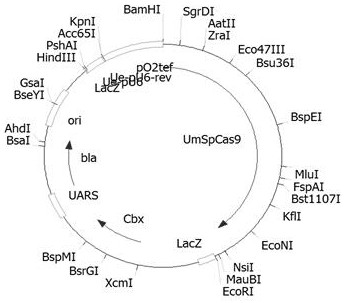Crispr/cas9 plasmid and its construction method and usage method
A plasmid and protoplast technology, applied in the biological field, can solve the problem of consuming manpower and material resources
- Summary
- Abstract
- Description
- Claims
- Application Information
AI Technical Summary
Problems solved by technology
Method used
Image
Examples
example 1
[0024] Example 1: Extraction of pMS7 plasmid
[0025] Use the Meiji Bio-endotoxin-free plasmid mini-extraction kit to extract the plasmid, and the specific steps are as follows:
[0026] 1. Inoculate the bacteria containing the pMS7 plasmid into a culture flask containing 15ml-20ml LB / carboxybenzyl culture solution, and culture on a shaker at 37°C for 12-16h to amplify the plasmid.
[0027] 2. Centrifuge at 3,000-5,000 x g for 10 minutes to collect 10-15ml of bacteria.
[0028] 3. Discard the medium, and gently tap on absorbent paper to absorb the residual liquid. Add 600µl Buffer E1 / RNase A, and vortex at high speed to fully resuspend the bacteria. RNase A must be added to Buffer E1 before use. Thorough resuspension of bacteria is critical to yield and no bacterial clumps should be visible after resuspension.
[0029] 4. Add 600µl Buffer E2 to the resuspension solution, invert and mix 6-8 times. Leave at room temperature for 1 to 2 minutes, and mix by inverting 2 to 3 ti...
example 2
[0040] Example 2: Linearization of the pMS7 plasmid
[0041] Enzyme digestion system (30 ul)
[0042] PMS7 plasmid DNA 4ul
[0043] Acc65I HF (neb) 1 ul
[0044] 1x Qcut Buffer 3 ul
[0045] dd H 2 O 22 ul
[0046] At 37°C, digest for 2h.
[0047] PCR products were detected by 1% agarose gel electrophoresis. After cutting the gel, it was recovered with the Magen Gel DNA Micro Recovery Kit. Store in a -20°C refrigerator for later use. pMS7 plasmid map as figure 1 shown. The pMS7 plasmid was digested with a single enzyme, such as image 3 As shown, the pMS7 plasmid was digested with the restriction endonuclease Acc65I to obtain a linearized fragment, which was recovered by rubber tapping to obtain the target fragment. The nucleotide sequence of the pMS7 plasmid is shown in SEQ ID No.1.
example 3
[0048] Example 3: Itd1 The long fragment of the gene sequence is ligated with the pMS7 vector cut by single enzyme
[0049] To complete this step, use the ClonExpress II OneStep Cloning Kit recombinant cloning kit produced by Nanjing Novizan Biotechnology Co., Ltd. Will Itd1 Partial fragment sequence of the gene (as shown in SEQ ID No.2), scaffold, and U6 terminator to synthesize a long fragment of Itd1-CRISPR, the nucleotide sequence of the Itd1-CRISPR is shown in SEQ ID No.4. The specific steps are as follows:
[0050] 1) Prepare the following reaction system on ice
[0051] Components (20ul)
[0052] pMS7 linearized vector 1.5ul
[0053] Itd1-CRISPR 1ul
[0054] 5×CEⅡ buffer 4 ul
[0055] Exnase II 2ul
[0056] dd H 2 O 11.5ul
[0057] (Note: The optimal amount of cloning vector used in the ClonExpress® II recombination reaction system is 0.03 pmol, and the optimal amount of insert used is 0.06 pmol (the molar ratio of vector to insert is 1:2). The DNA quality c...
PUM
 Login to View More
Login to View More Abstract
Description
Claims
Application Information
 Login to View More
Login to View More - R&D
- Intellectual Property
- Life Sciences
- Materials
- Tech Scout
- Unparalleled Data Quality
- Higher Quality Content
- 60% Fewer Hallucinations
Browse by: Latest US Patents, China's latest patents, Technical Efficacy Thesaurus, Application Domain, Technology Topic, Popular Technical Reports.
© 2025 PatSnap. All rights reserved.Legal|Privacy policy|Modern Slavery Act Transparency Statement|Sitemap|About US| Contact US: help@patsnap.com



